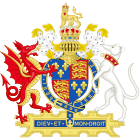Act of Union 1536

|
|
| Long title | An Acte for Laws & Justice to be ministred in Wales in like fourme as it is in this Realme |
|---|---|
| Citation | 27 Henry VIII c. 26 |
| Territorial extent | Wales, Marcher Lordships |
| Dates | |
| Repealed | 21 December 1993 |
| Other legislation | |
| Repealed by | Welsh Language Act 1993 |
|
Status: Repealed
|
|
| Text of statute as originally enacted | |

|
|
| Long title | An Acte for certaine Ordinaunces in the Kinges Majesties Domynion and Principalitie of Wales |
|---|---|
| Citation | 34 & 35 Henry VIII c. 26 |
| Territorial extent | Wales, Marcher Lordships |
| Dates | |
| Repealed | 3 January 1995 |
| Other legislation | |
| Repealed by | Welsh Language Act 1993 |
|
Status: Amended
|
|
| Text of statute as originally enacted | |
 |
|
| Treaty of Union | 1706 |
|---|---|
| Acts of Union | 1707 |
| Personal Union of 1714 | 1714 |
| Wales and Berwick Act | 1746 |
| Irish Constitution | 1782 |
| Acts of Union | 1800 |
| Government of Ireland Act | 1920 |
| Anglo-Irish Treaty | 1921 |
| Royal and Parliamentary Titles Act | 1927 |
| N. Ireland (Temporary Provisions) Act | 1972 |
| European Communities Act | 1972 |
| Local Government Act | 1972 |
| Local Government (Scotland) Act | 1973 |
| Northern Ireland Assembly | 1973 |
| N. Ireland Constitution Act | 1973 |
| Referendum Act | 1975 |
| Scotland Act | 1978 |
| Wales Act | 1978 |
| Local Government (Wales) Act | 1994 |
| Local Government etc. (Scotland) Act | 1994 |
| Referendums (Scotland & Wales) Act | 1997 |
| Good Friday Agreement | 1998 |
| Northern Ireland Act | 1998 |
| Government of Wales Act | 1998 |
| Scotland Act | 1998 |
| Government of Wales Act | 2006 |
| Northern Ireland Act | 2009 |
| European Union Act | 2011 |
| Scotland Act | 2012 |
| Edinburgh Agreement | 2012 |
| Wales Act | 2014 |
| European Union Referendum Act | 2015 |
| Scotland Act | 2016 |
| Wales Act | 2017 |
The Laws in Wales Acts 1535 and 1542 (Welsh: Y Deddfau Cyfreithiau yng Nhgymru 1535 a 1542) were parliamentary measures by which Wales became a full and equal part of the Kingdom of England and the legal system of England was extended to Wales and the norms of English administration introduced. The intention was to create a single state and legal jurisdiction. The Acts were passed during the reign of King Henry VIII of England, who came from the Welsh Tudor dynasty.
Before these Acts, Wales was excluded from Parliamentary representation and divided between the Principality of Wales, and a large number of feudal statelets; the marcher lordships.
The Act declared King Henry's intentions, that because of differences in law and language:
- and therefore:
They are sometimes misleadingly known as the Acts of Union (Welsh: Y Deddfau Uno), but the legal short title of each Act has since 1948 been "The Laws in Wales Act". They are also often seen cited by the years they received Royal Assent, 1536 and 1543 respectively, although the official citation uses the contemporary year in which the parliamentary session began. In the case of each of these Acts this date occurred between 1 January and 25 March, adding to the ambiguity in the dating because of the use at that time of the Julian or "old style" calendar and observed New Year's Day on 25 March rather than 1 January.
From the conquest of Gwynedd in 1282–83 until the passing of the Laws in Wales Acts, the administrative system of Wales had remained unchanged. By the Statute of Rhuddlan in 1284 the territory of the native Welsh rulers had been broken up into the five counties of Anglesey, Caernarfon, Cardigan, Carmarthen, and Merioneth. Even though the five counties were subject to English criminal law, the "Principality" was the king of England's own personal fief and Welsh law continued to be used for civil cases. The rest of Wales, except for the county of Flint, which was part of the Principality, and the Royal lordships of Glamorgan and Pembroke, was made up of numerous small lordships, each with its own courts, laws and other customs.
...
Wikipedia
